Alcohol and late night refreshment licensing England and Wales, year ending 31 March 2022
Published 13 October 2022
Applies to England and Wales
Frequency of release: Biennially
Forthcoming releases: Home Office statistics release calendar
Home Office responsible statistician: Jenny Bradley
Press enquiries: pressoffice@homeoffice.gov.uk
Telephone: 0300 123 3535
Public enquiries: PolicingStatistics@homeoffice.gov.uk
1. Summary
As at 31 March 2022, there were:
- 817,100 personal licences, a 13% increase compared with 31 March 2018 (723,800)
- 222,500 premises licences, a 5% increase compared with 31 March 2018 (212,800)
- 13,500 club premises certificates, a 4% decrease compared with 31 March 2018 (14,100)
- 10,600 premises with 24-hour alcohol licences, a 31% increase compared with 31 March 2018 (8,100)
- 189 cumulative impact areas in place
A public consultation on alcohol and late night refreshment licensing statistics was held in October 2018, and in response data are now collected from licensing authorities (LAs) every other year using a reduced questionnaire. This has reduced the burden on LAs whilst ensuring the continuity of key headline statistics. Data for the year ending 31 March 2020 were not collected due to the COVID-19 pandemic which began on 12 March 2020. As such, data have not been collected in each of the last three years, so in this publication comparisons are made with 2018 to provide a measure of change over time.
2. Introduction
Businesses, organisations and individuals who want to sell or supply alcohol in England and Wales must have a licence or other authorisation from a licensing authority – usually a local council. The law and policy governing this area is overseen by the Home Office. The types of businesses and organisations that need alcohol licences might include pubs and bars, cinemas, theatres, nightclubs, late-opening cafes, takeaways, village and community halls, shops and supermarkets.
The types of licences required are defined as follows:
- any business or other organisation that sells or supplies alcohol on a permanent basis needs to apply for a premises licence
- anyone who plans to sell or supply alcohol or authorise the sale or supply of alcohol must apply for a personal licence
- qualifying members’ clubs (such as the Royal British Legion, or rugby clubs for example) need to apply for a club premises certificate if they plan to sell or supply alcohol
To allow meaningful comparisons to be made between years, the headline figures include imputed estimates for the 3 LAs unable to supply data in the year ending 31 March 2022. These figures are rounded to the nearest hundred.
The user guide includes coverage of the data, a glossary of terms and information on the conventions used in the statistics, legislation and regulations.
The accompanying data tables provide supplementary data to those presented in this release, including imputed estimates for the headline figures.
3. Increase in personal licences does not necessarily reflect increase in active licence holders
A personal licence authorises an individual to supply or authorise the supply of alcohol in accordance with a premises licence under the 2003 Act.
As at 31 March 2022, there were 817,100 personal licences in England and Wales, a 13% increase (+93,300) compared with 31 March 2018 (723,800). Since a personal licence is valid for the lifetime of the holder (unless surrendered, revoked or suspended), as new licences are issued the number in circulation accumulates. Therefore, the upward trend seen since 2012 (Figure 1), does not necessarily reflect an increase in active personal licence holders over this time.
Figure 1: Personal licences, England and Wales, as at 31 March 2012 to 31 March 2022
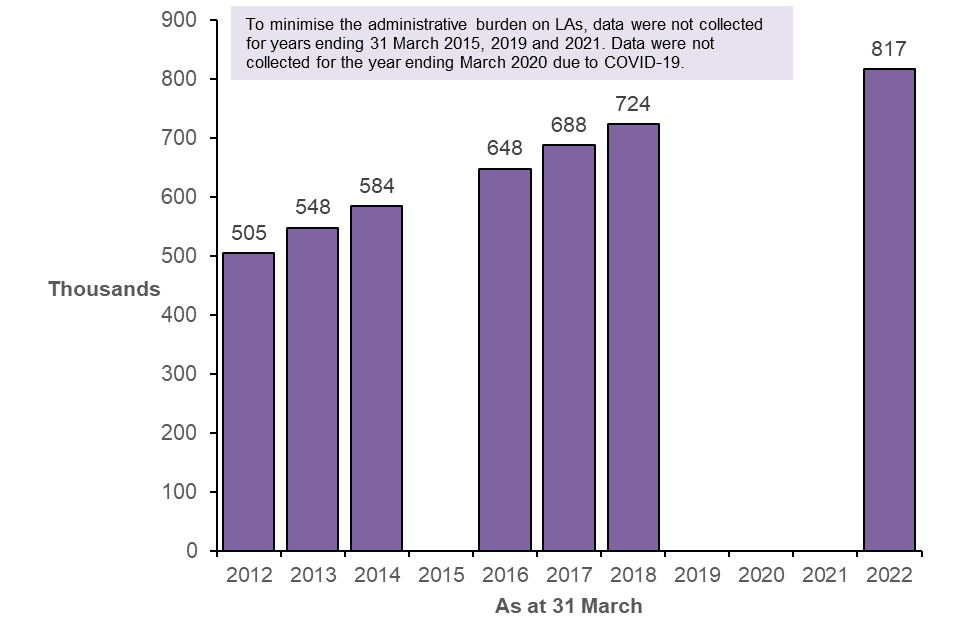
Note:
- Includes imputed estimates.
Birmingham LA had the highest number of personal licences as at 31 March 2022 (12,412) and 31 March 2018 (10,695).
4. Increase in premises licences to highest number since comparable records began
A premises licence gives authority under the 2003 Act for a premises to be used for the sale of alcohol, the provision of regulated entertainment, or the provision of late night refreshment. Premises licences require an annual fee and renewal so do not accumulate in the same way that personal licences do.
As at 31 March 2022, there were 222,500 premises licences in England and Wales, an increase of 5% (+9,700) compared with 31 March 2018 (212,800). This was the highest number of premises licences since comparable records began in 2008 (195,800).
Figure 2: Premises licences, England and Wales, as at 31 March 2012 to 31 March 2022

Note:
- Includes imputed estimates.
As shown in Figure 2, the number of premises licences has steadily increased since 2012 (from 201,500 to 222,500; a 10% increase of 21,000). Westminster LA had the highest number of premises licences as at 31 March 2022 (3,976), and in all years since 31 March 2014.
Figure 3: Premises licences by England region areas and Wales, as at 31 March 2022

Notes:
- Ranked by the highest to lowest number of premises licences.
- Excludes imputed estimates.
As at 31 March 2022, the London region had the highest number of premises licences (33,840) and the North East region had the fewest (8,448).
Per 100,000 population, Wales had the highest number of premises licenses (440) and the North East of England had the fewest (319), as shown in Figure 4.
Figure 4: Premises licences, per 100,000 people by England region areas and Wales, as at 31 March 2022
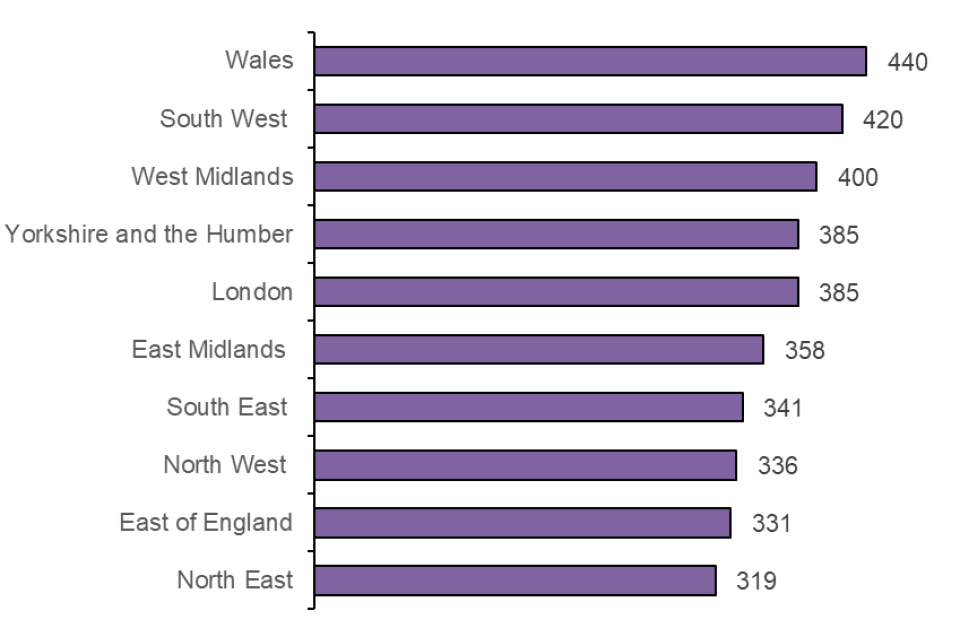
Source: Home Office, Alcohol and late night refreshment licensing, England and Wales, year ending 31 March 2022, Table 2 and Population and household estimates, England and Wales: Census 2021.
Notes:
- Ranked by the highest to lowest number of premises licences, per 100,000 people.
- Excludes imputed estimates.
5. Club premises certificates have steadily declined over the past 10 years
A club premises certificate allows a qualifying club to carry out activities specified under the Licensing Act 2003 (the 2003 Act).
As at 31 March 2022, there were 13,500 club premises certificates in England and Wales, a 4% decrease (-600) compared with 31 March 2018 (14,100). As shown in Figure 5, the number of club premises certificates has steadily declined since 2012 (from 15,900 in 2012 to 13,500 in 2022). West Suffolk LA had the highest number of club premises certificates (299) as at 31 March 2022.
Figure 5: Club premises certificates, England and Wales, as at 31 March 2012 to 31 March 2022
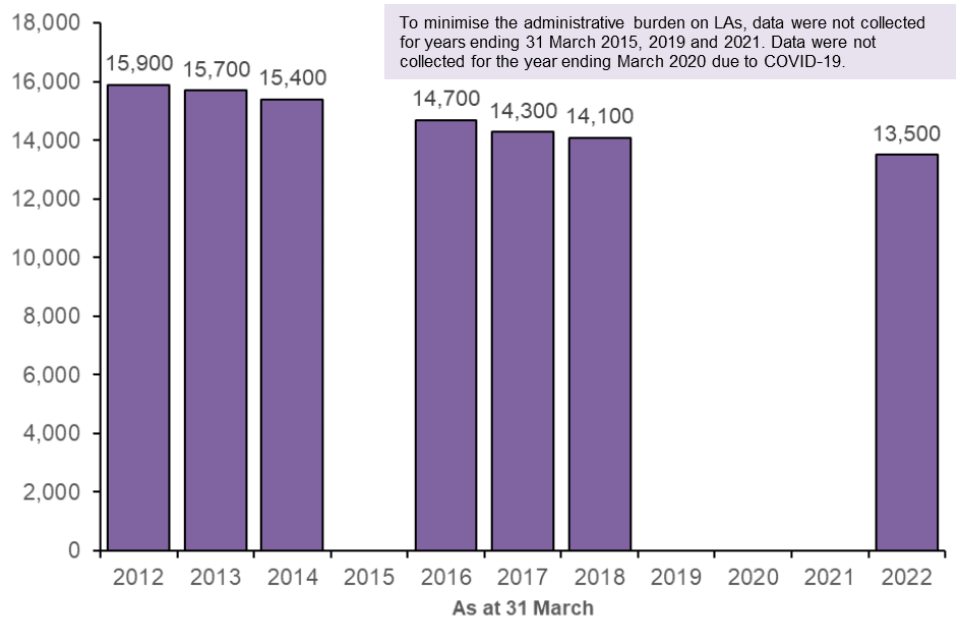
Note:
- Includes imputed estimates.
6. Decrease in cumulative impact areas
Cumulative impact areas (CIAs) are identified by LAs where there is evidence that the number, type or density of licensed premises are giving rise to specific problems that could undermine the licensing objectives (i.e. the prevention of crime and disorder, public safety, the prevention of public nuisance, and the protection of children from harm).
As at 31 March 2022, there were 86 LAs with a total of 189 CIAs in place (excluding imputed estimates). This compares with 107 LAs with a total of 222 CIAs in place as at 31 March 2018. The highest concentration of CIAs was in Brent LA (10), Croydon LA (8) and Newcastle upon Tyne LA (8). Changes were made to the licensing Act 2003 in 2018 relating to the assessment of prospective CIAs which may have affected the number that were implemented from this time.
7. Late night levies raised £2.4 million in the year ending 31 March 2022
In October 2012, LAs were given the power to introduce a late night levy through the Police Reform and Social Responsibility Act 2011. This allows LAs to raise a contribution from late-opening alcohol suppliers towards policing the night-time economy. Late night levies must cover the entire LA area and apply for a specified period between 12am and 6am.
As at 31 March 2022, 9 LAs had a late night levy in place. The total amount raised in the year ending 31 March 2022 by late night levies across 8 of the 9 LAs that provided information was around £2.4 million. This is a 41% increase (+£0.7 million) compared with the year ending 31 March 2018 (£1.7 million; 8 LAs with a late night levy). Of the 9 LAs with late night levies in place, 5 were in the London region area: City of London, Hackney, Islington, Southwark, and Tower Hamlets, in addition to Chelmsford, Liverpool, Newcastle upon Tyne and Nottingham.
Figure 6: Total amount raised by late night levies, England and Wales, year ending 31 March 2022
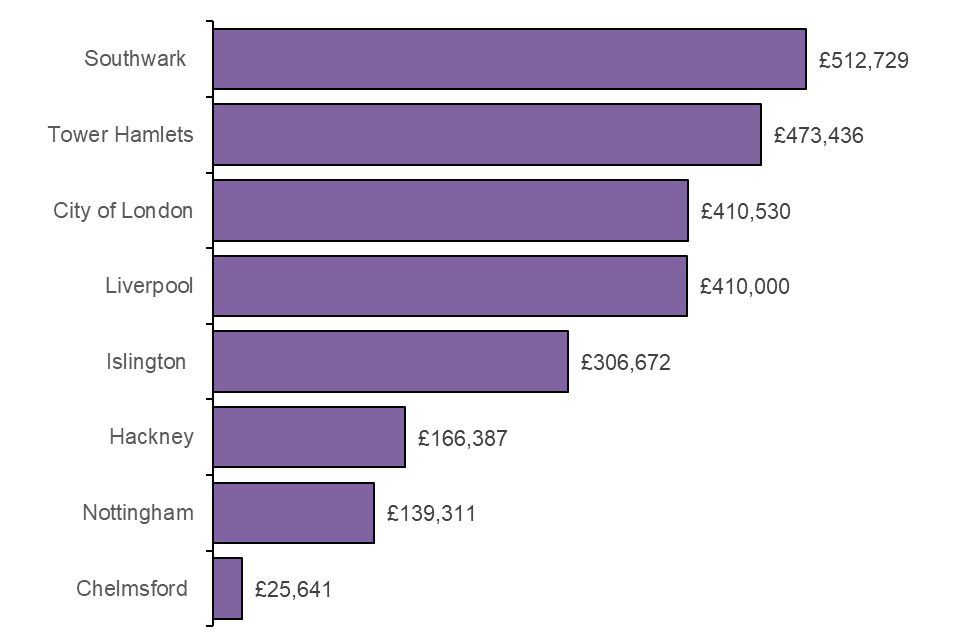
Notes:
- Ranked from the highest to lowest amount raised by late night levies.
- Data for Newcastle upon Tyne is not available.
- Excludes imputed estimates.
8. Long term decline in premises licence reviews
An LA can be asked, by responsible authorities such as the police, local environmental health authority, local fire and rescue service, local public health body and other persons, to review a premises licence on the grounds of it having an adverse impact on the licensing objectives (i.e. the prevention of crime and disorder, public safety, the prevention of public nuisance, and the protection of children from harm).
In the year ending 31 March 2022, 347 premises licence reviews were carried out. This was a 43% decrease (-264) compared with the year ending 31 March 2018 (611) and continues the long term decline since the year ending 31 March 2010 (around 1,300, including imputed estimates). Of the 347 licences reviewed, almost half (167; 48%) were revoked or withdrawn.
Table 1: Completed premises licence reviews, England and Wales, years ending 31 March 2022 and 31 March 2018
| Reason | Completed reviews year ending 31 March 2022 | Completed reviews year ending 31 March 2018 | Percentage change |
|---|---|---|---|
| Total | 347 | 611 | -43% |
| Crime and disorder | 290 | 505 | -43% |
| Public safety | 132 | 160 | -18% |
| Public nuisance | 119 | 154 | -23% |
| Protection of children | 102 | 141 | -28% |
Notes:
- Excludes imputed estimates.
- Note that more than one reason can be given per review.
9. 24-hour alcohol licences increase by 31%
A 24-hour licence refers to premises that are licensed for the sale or supply of alcohol 24 hours per day (but may not operate 24 hours per day).
As at 31 March 2022, there were 10,600 premises with 24-hour alcohol licences, a 31% increase (+2,500) compared with 31 March 2018 (8,100).
Figure 7: Premises with 24-hour alcohol licences by premises type, England and Wales, as at 31 March 2022
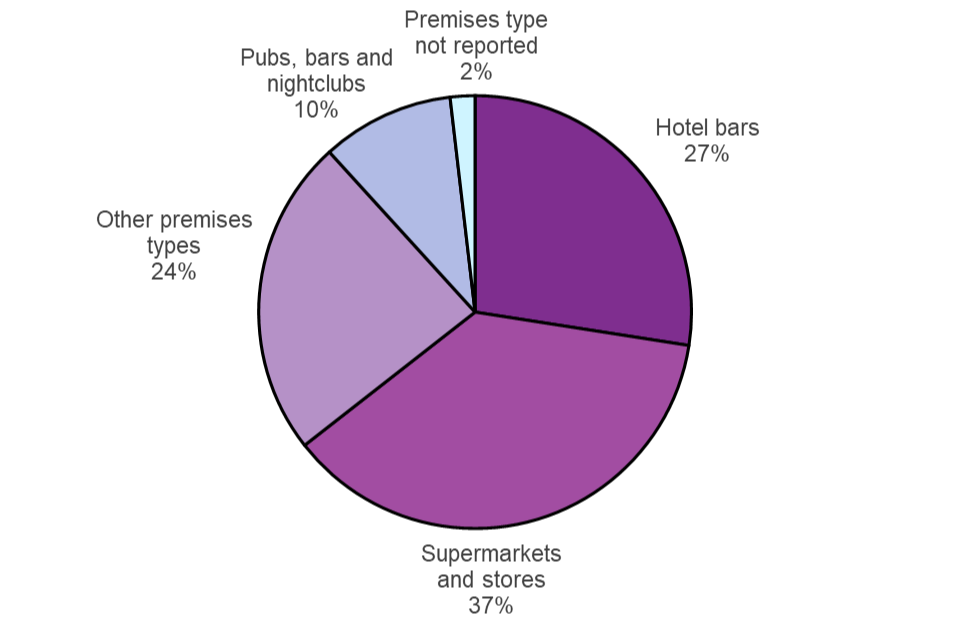
Note:
- Excludes imputed estimates.
10. Temporary event notices (TENs) decreased by 33%
TENs are used to authorise one-off events involving licensable activities, subject to certain criteria and limits.
In the year ending 31 March 2022, including imputed estimates, 98,500 TENs were used which represents a 33% decrease (-48,700) compared with the year ending 31 March 2018 (147,200). It is likely that this decrease is in part related to the COVID-19 pandemic and related restrictions.
